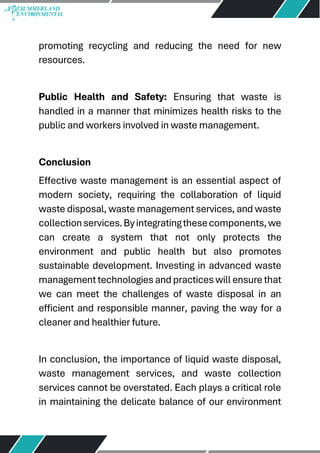An Unbiased View of Reclaim Waste
An Unbiased View of Reclaim Waste
Blog Article
3 Easy Facts About Reclaim Waste Shown
Table of ContentsLittle Known Facts About Reclaim Waste.The Best Strategy To Use For Reclaim WasteThe Definitive Guide to Reclaim WasteReclaim Waste - The FactsReclaim Waste - An Overview
Domestic sewage waste refers to the waste and products from a residential septic tank. The correct management and disposal of domestic sewage waste need fluid waste to be transferred to a sewage therapy plant where the appropriate techniques and tools are applied to purify and dispose of waste.
Commercial waste commonly consists of prospective dangers, such as combustible materials or a mix of fluid and solid waste products, and calls for a much more advanced and detailed disposal process. The disposal of industrial waste typically involves the filtering of waste prior to transport to make certain secure and proper disposal. Hazardous waste is developed from results and overflow of industrial processes and production.
This type of waste can not utilize the exact same sewer administration transportation or processes as septic or industrial fluids. The industrial waste monitoring procedure needs the evaluation and screening of fluid waste prior to it undertakes the disposal procedure (liquid waste disposal). Overflow waste is the liquid waste that originates from drainage and excess stormwater in extremely populated areas or cities
Drainage waste can create contamination and flooding if not managed properly. Making sure correct waste monitoring can avoid calamities and reduce ecological injury.
Get This Report on Reclaim Waste
Get in touch with PROS Solutions today to learn more about our waste monitoring and disposal services and the appropriate methods to care for the fluid waste you produce.
(https://gravatar.com/maximum5d830db060)Do you understand what takes place to your water when you disengage, flush the bathroom or drain the washing equipment? No? Well, it deserves recognizing. This supposed 'wastewater' is not only an important source yet, after treatment, will be released to our land, waterways or the ocean. Used water from commodes, showers, baths, kitchen area sinks, washings and commercial procedures is referred to as wastewater.

water made use of to cool down equipment or clean plant and equipment). Stormwater, a kind of wastewater, is overflow that moves from agricultural and city areas such as roof coverings, parks, gardens, roads, paths and rain gutters into stormwater drains, after rain. Stormwater streams without treatment straight to regional creeks or rivers, eventually reaching the ocean.
About Reclaim Waste
In Queensland, a lot of wastewater is treated at sewage therapy plants. Wastewater is transported from domestic or commercial sites with a system of sewers and pump terminals, known as sewerage reticulation, to a sewer treatment plant.
The Division of Natural Resources recommends city governments about handling, operating and maintaining sewage systems and therapy plants. In unsewered areas, regional federal governments may need householders to install specific or household sewage therapy systems to deal with residential wastewater from bathrooms, kitchens, washrooms and laundries. The Division of Natural Resources authorizes the usage of household systems when they are shown to be reliable.
In some brand-new subdivisions, treatment of some stormwater to remove litter, sand and crushed rock has actually begun utilizing gross contaminant catches. Wastewater therapy occurs in four phases: Gets rid of solid matter.
Wastewater after that moves into large storage tanks where solids clear up and are gotten rid of as sludge. Grease and scum are skimmed from the surface. Utilizes little living microorganisms called micro-organisms to break down and eliminate continuing to be dissolved wastes and fine bits. Micro-organisms and wastes are integrated in the sludge. Gets rid of nitrogen and phosphorus nutrients that could trigger algal flowers in our waterways and threaten water life.
The Best Strategy To Use For Reclaim Waste
Nutrient elimination is not offered at all sewage treatment plants since it needs expensive specialised tools. Clear fluid effluent created after therapy may still consist of disease-causing micro-organisms - liquid waste disposal.

This generally suggests wastewater needs to be dealt with or contaminants removed prior to it can be discharged to rivers. The majority of wastewater moves right into the sewerage system. Under the Act, city governments carry out approvals and licences for eco appropriate activities (Periods) entailing wastewater releases that may have a regional effect. The department provides approvals and permits to Ages entailing wastewater launches that may have a local or statewide impact.
See This Report on Reclaim Waste
Tracking gives accurate details regarding water top quality and can verify that permit conditions are being fulfilled. The info acquired through monitoring gives the basis for making water top quality decisions.
Report this page